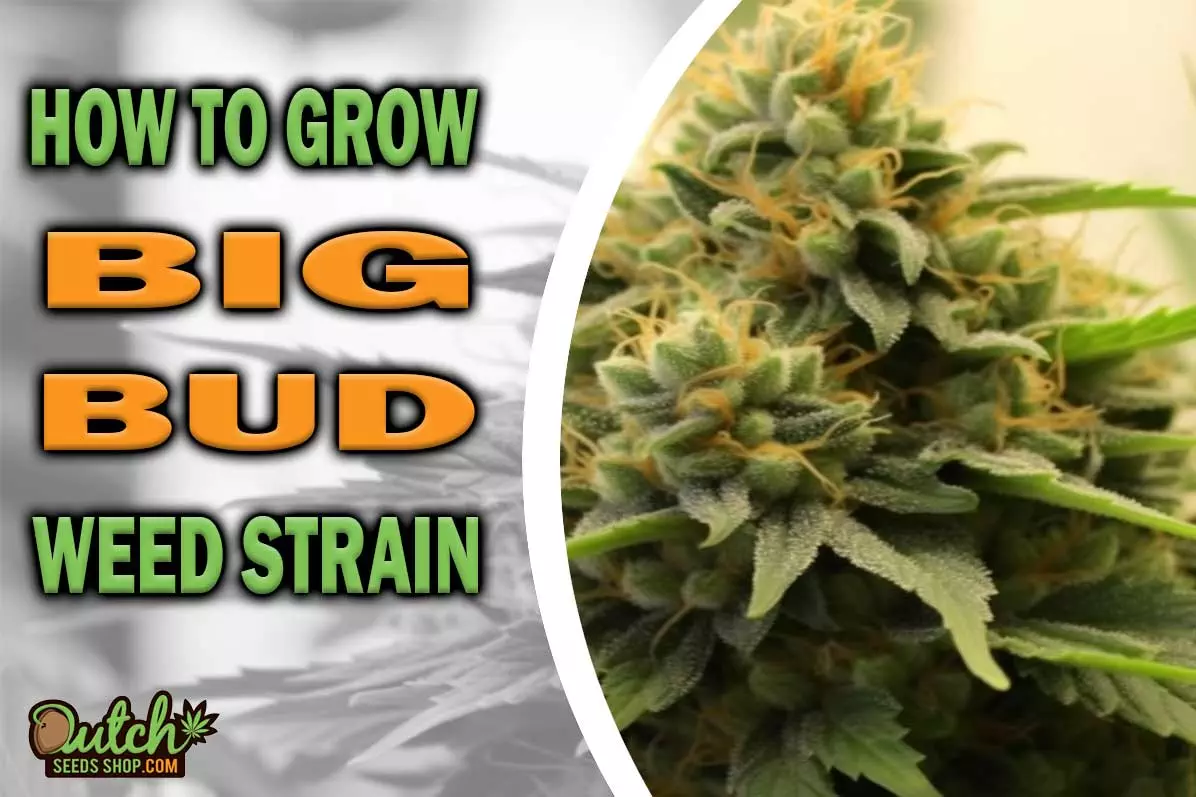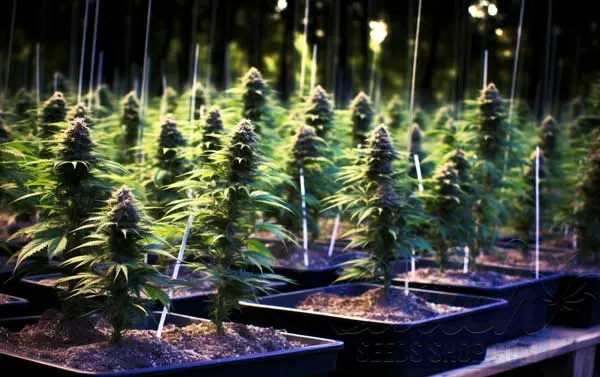How to Grow Big Bud Strain
The Big Bud strain stands out in the cannabis world for its remarkable characteristics, including its potent effects, distinct aroma, and impressive size. This guide offers an in-depth look into cultivating this unique strain, providing valuable insights for both novice and experienced growers.

Get To Know Big Bud Strain
Big Bud, a predominantly Indica strain, boasts a rich lineage from Afghani, Northern Lights, and Skunk #1.
It’s renowned for its high THC levels (23%-26%) and minimal CBD content (below 1%).
This strain has garnered attention for its potent effects and flavors, including spicy, earthy, and woody notes, delivering a euphoric and relaxed experience.
Its ease of cultivation and significant yields have made it a popular choice among growers.
| Characteristic | Detail |
| Lineage | Afghani, Northern Lights, Skunk #1 |
| THC/CBD Content | 23%-26% THC, <1% CBD |
| Flavors | Spicy, Earthy, Woody, Herbal |
| Effects | Euphoric, Happy, Relaxed, Sleepy |
| Grow Difficulty | Easy |
| Flowering Time | 60-65 days |
| Yield | High (Indoor and Outdoor) |
Tips and Tricks for Growing Big Bud Successfully
To successfully grow Big Bud, understanding its growth stages and requirements is crucial.
This strain is relatively easy to cultivate, thriving in a warm climate with a medium height and a flowering time of 60-65 days.
For optimal results, consider the following:
- Seed Selection: Choose quality seeds or clones.
- Cultivation Accessories: Obtain necessary tools and equipment.
- Growth Stages: Monitor and cater to each stage’s needs.
- Flowering Time: Ensure optimal conditions during this critical period.
- Harvesting Techniques: Learn the right time and method for harvesting.
Big Bud Indoor Growing
Growing Big Bud indoors presents a unique set of benefits and challenges.
Known for its robust nature and substantial yields, this strain can thrive in a controlled indoor environment.
The key lies in understanding the specific requirements of Big Bud and implementing strategies to maximize its growth potential.
Benefits of Indoor Growing

Indoor cultivation of Big Bud seeds offers significant advantages.
Firstly, controlled environmental factors lead to high-quality weed with consistent potency and flavor.
Growers can achieve multiple harvests throughout the year, a feat not possible with outdoor cultivation.
Additionally, indoor growing provides enhanced privacy and security, essential in areas where cannabis cultivation might attract unwanted attention.
Real-life examples include urban growers who, despite limited space, produce remarkable yields using indoor setups.
- Controlled Environment
- Quality and Consistency
- Multiple Harvests
- Privacy and Security
Setting Up Your Indoor Grow Space
Setting up an indoor grow space for Big Bud requires careful consideration.
Choose a dedicated space like a closet, grow tent, or spare room.
Ensure proper ventilation to control odor and maintain air quality.
The type of grow lights used can significantly impact plant growth; options include HID, LED, and fluorescent lights.
Start small to manage costs effectively, while providing adequate space for plant development.
- Select a suitable grow space.
- Install proper ventilation systems.
- Choose appropriate grow lights.
- Manage initial setup costs.
Climate Control
Effective climate control is critical for the healthy growth of Big Bud indoors.
Temperature and humidity must be carefully monitored and regulated.
Use environmental controllers for automation to maintain optimal conditions.
Employ air-cooled reflector hoods for HID lights and oscillating fans to ensure even air circulation.
Adjusting these variables is vital for preventing issues like mold or heat stress.
Types of Lights

Different types of grow lights play distinct roles in the development of Big Bud.
HID lights are favored for their intensity, ideal for both vegetative growth (Metal Halide) and flowering (High Pressure Sodium).
Fluorescent lights are more suited for small-scale growers or seedlings.
LED lights offer energy efficiency and a full spectrum of light, beneficial for the entire lifecycle of the plant.
- HID Lights
- Fluorescent Lights
- LED Lights
Growing Mediums and Containers
Choosing the right growing medium and containers is essential for Big Bud.
Soil is a traditional medium, forgiving for beginners.
Hydroponics offer advanced control over nutrients but require more expertise.
Container choices range from standard plastic pots to fabric containers, which promote better airflow and healthier root systems.
Ensure proper drainage to prevent root rot.
Caring for Indoor-Grown Big Bud
Caring for Big Bud strain indoors involves regular routines like watering with clean, pH-balanced water and nutrient management, using specific nutrient solutions.
Pruning helps maintain plant health and shape.
Monitor for early signs of pests or diseases and implement appropriate measures to combat them.
Odor Control
Controlling odor is an important aspect of indoor cultivation.
Activated carbon filters are effective in removing odors, while proper air circulation using exhaust and intake fans is crucial.
Odor-absorbing gels can also be used as an additional measure to mask the smell of growing cannabis.
Big Bud Outdoor Growing
Shifting to the outdoors, the cultivation of Big Bud presents a different set of dynamics.
The outdoor environment offers both challenges and opportunities for this strain, making it essential for growers to understand the best practices for maximizing its potential in a natural setting.
Benefits of Outdoor Growing

Outdoor cultivation of Big Bud is associated with several benefits.
It is cost-effective, as it reduces the need for expensive lighting and climate control systems.
Outdoor plants typically yield more, owing to the space and natural resources available.
This method is environmentally sustainable, utilizing natural light and reducing energy consumption.
Furthermore, gardening outdoors offers therapeutic benefits, making it a relaxing and fulfilling hobby for many growers.
| Benefit | Description |
| Cost-Effectiveness | Reduced need for equipment and energy |
| Larger Yields | More space and natural resources |
| Environmental Impact | Utilizes sunlight, less energy use |
| Therapeutic Value | Relaxing and fulfilling gardening |
Best Time to Plant Big Bud Outdoors
Planting Big Bud outdoors should be timed according to regional climate variations.
In the Northern Hemisphere, April or May is ideal.
Start with germination and seedling stages indoors to protect them from early spring frosts.
Transplanting to the outdoors should be done only when the risk of frost has passed.
Setting Up Outdoor Grow Spaces
Creating an outdoor grow space for Big Bud requires understanding the local climate and selecting a spot with adequate sunlight and wind protection.
Consider garden plots, balconies, or rooftops depending on your space and privacy needs.
- Assess local climate conditions.
- Choose a location with sufficient sunlight.
- Implement wind protection measures.
- Select a suitable type of outdoor grow space.
Selecting and Preparing Soil

Soil selection and preparation are key for outdoor cultivation of Big Bud.
Test your soil to understand its composition – a balance of clay, sand, and silt is ideal.
If the natural soil isn’t optimal, consider buying quality potting soil or pre-fertilized “super-soil”.
This helps ensure that the plants have the necessary nutrients throughout their growth cycle.
Nutrients and Fertilizers
Nutrition is crucial for Big Bud grown outdoors.
The plants require nitrogen, phosphorus, and potassium at different stages of growth.
Choose between organic fertilizers, like bone meal and kelp meal, or synthetic options.
Also, plan an irrigation and nutrient schedule to maintain consistent growth.
- Nitrogen, Phosphorus, Potassium
- Organic vs. Synthetic Fertilizers
- Irrigation and Nutrient Scheduling
How to Maximize Big Bud Yield
To maximize the yield of Big Bud, both indoors and outdoors, consider advanced cultivation techniques.
Training methods, such as pruning and trellising, can greatly enhance plant health and yield.
Factors like CO2 enrichment and optimizing light intensity are key for indoor cultivation, while outdoor growers should focus on maximizing sunlight exposure and protecting plants from adverse weather conditions.
Growing Big Bud offers a blend of challenges and rewards, making it a fulfilling endeavor for both novice and experienced cultivators.
This strain’s robust nature and impressive yield make it a valuable addition to any garden.
Its adaptability to both indoor and outdoor environments allows for a range of cultivation experiences.
By mastering the cultivation of Big Bud, growers can enjoy its potent effects and aromatic buds, benefiting from its therapeutic and recreational properties.
The journey from seed to harvest with Big Bud is not just about producing cannabis; it’s about the satisfaction of nurturing and reaping the rewards of your dedication and care.
FAQs
Can Big Bud be grown in colder climates?
Big Bud can be grown in colder climates, but it requires extra care. Use greenhouses or indoor setups to maintain a warm and stable environment during the colder months.
How often should I water Big Bud plants?
Water Big Bud plants when the top inch of soil feels dry. Overwatering can lead to root rot, so ensure proper drainage and monitor soil moisture levels regularly.
Is Big Bud resistant to pests and diseases?
Big Bud has a natural resilience against pests and diseases, but regular monitoring is essential. Use organic pest control methods and maintain clean growing conditions to prevent infestations.
Can Big Bud be grown hydroponically?
Yes, Big Bud thrives in hydroponic setups. This method allows for better control over nutrients and can lead to faster growth and higher yields.
What is the ideal pH level for growing Big Bud?
The ideal pH level for growing Big Bud is between 6.0 and 7.0. Regularly test and adjust the pH of your water and soil or hydroponic solution to maintain this range.
About the Author
Share the Love:
